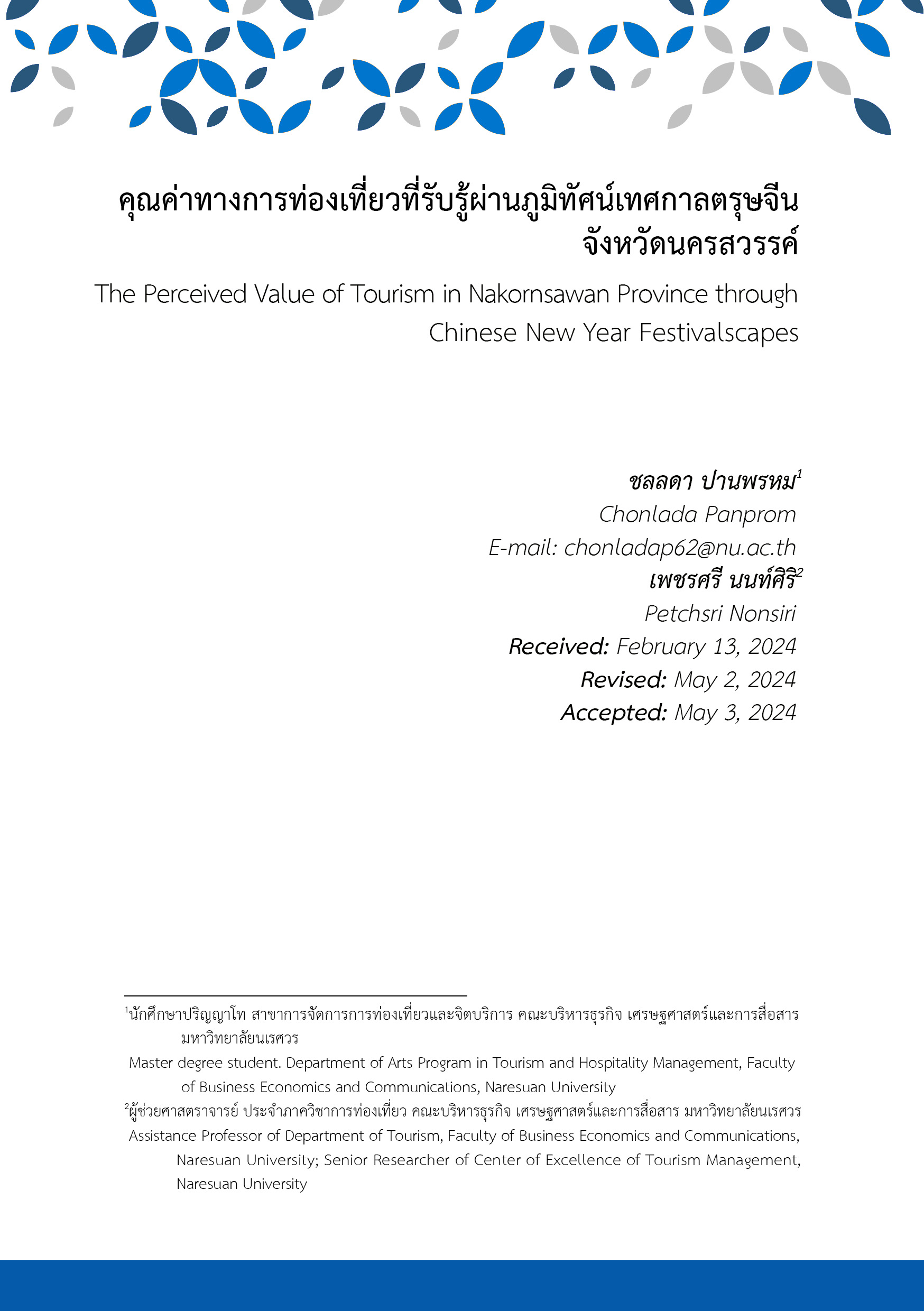The Perceived Value of Tourism in Nakornsawan Province through Chinese New Year Festivalscapes คุณค่าทางการท่องเที่ยวที่รับรู้ผ่านภูมิทัศน์เทศกาลตรุษจีน จังหวัดนครสวรรค์
Main Article Content
Abstract
This research aims to investigate the delivery of tourism value from the perspectives of both stakeholders and visitors during the Chinese New Year Festivalscapes in Nakhon Sawan Province. The research revealed a comprehensive total of 5 dimensions of tourism value. Firstly, for the Spiritual Value, it was discovered that the festival possesses auspiciousness, bestows favors, dispels negative influences, and inspires faith. Secondly, the Functional Value is evident from the presence of the local culture that promotes visitors to acquire a more profound comprehension by means of the lion dance parade. Thirdly, for the Social Value, the phenomenon emerges as a result of the social engagement between the host and the visitor as well as the act of returning to one's place of residence and exchanging experiences via social media. Fourthly, for the Emotional Value, the festival is characterized by enthusiasm, enjoyment, grandeur, and visual appeal. Finally, the Conditional Value is dependent on certain conditions being met such as the festival's link and other tourism attractions in the province. This study has established practical recommendations for event organizers to maintain the tourism value of the Chinese New Year Festival in Nakhon Sawan province. These guidelines include promoting the functional value of the festival by effectively communicating the essence of local culture using suitable information technology tools that align with the festival's core content. In addition, the core materials include activities that serve as the foundation for the Chinese New Year Festival such as the Golden Dragon Parade and the rituals for selecting the symbolic image of Guan Yin, which contribute to the development of spiritual values. The utilization of the fortune-telling rituals (Pawapuay) for the purpose of selecting an organizer for the Chinese New Year event might be advocated as an approach to maintain the fundamental principles of the event.
Downloads
Article Details

This work is licensed under a Creative Commons Attribution-NonCommercial-NoDerivatives 4.0 International License.
References
Ahithan, S. (2019). The Influences of Perceived Emotional Value Perceived Price Value and Service Quality on Satisfaction Relationship Quality Word of Mouth and Revisit of Using Hotel Services in Bangkok (Master’s Thesis). Retrieved from http://dspace.bu.ac.th/jspui/handle/123456789/3877
Ashton, A.S., Limisariyapong, S., & Islam, R. (2020). The development of value perception toward cultural tourism destination: a Northeast Thailand case study. ESTEEM Journal of Social Sciences and Humanities, 2020 (4), 243-252. Retrieved from https://ejssh.uitm.edu.my/images/Vol4Jan20/PItCH_26.pdf
Babin, B. (2008). Festivalscapes and patrons' emotions, satisfaction, and loyalty. Journal of Business Research, 2008 (61), 56–64. Retrieved from https://www.academia.edu/11773475/Festivalscapes_and_patrons_emotions_satisfaction_and_loyalty
Chen, V., King, B., & Suntikul, W. (2019). Festivalscapes and the visitor experience: An application of the Stimulus Organism Response approach. International Journal of Tourism Research, 21(3), 1-24. Retrieved from https://www.researchgate.net/publication/334091197_Festivalscapes_and_the_visitor_experience_An_application_of_the_Stimulus_Organis m_Response_approach
Department of Cultural Promotion. (2019). The Paknampho Chinese God Festival.Retrieved from http://ich.culture.go.th/heritage/detail/62b290dcf7be8fc407c58180
Dinfa, P. (2014). The tradition of belief in the Pak Nam Pho Goddess-Goddess procession at present that affects life of Thai people of Chinese descent Pak Nam Pho Subdistrict, Mueang District, Nakhon Sawan Province. Journal of Thai Hospitality and Tourism, 9(2), 45–59. Retrieved from https://so04.tci- thaijo.org/index.php/tourismtaat/article/view/24841
Faimanotham, C. (2021). The development of cultural area as a Pop culture tourism (Master’s Thesis). Retrieved from https://nuir.lib.nu.ac.th/dspace/bitstream/123456789/5270/3/ChonnipaFaimanotham.pdf
Hiranyapan, T. (2020). Statue of Guan Yin a representative of the beliefs and faith of the people of Pak Nam Pho, Mueang District, Nakhon Sawan Province (Master’s Thesis). Retrieved from https://sure.su.ac.th/xmlui/bitstream/handle/123456789/23543/BA_Thitirat_%20Hirunyaphan.pdf?sequence=3&isAllowed=y
Liaotrakul, J., Khor Charoen, M., & Netphokaew, A. (2016). Thai-Chinese Ethnic Identity Transmit and Reflect Through A Century of Pak Nam Po Chinese New Year Festival in NokhonSawan. Dhurakij Pundit Communication Arts Journal, 10(1), 11-38. Retrieved from https://commarts.dpu.ac.th/journal/upload/issue/XQIDMDHroq
Nalin, S., Chotima, J., Onputtha, S., & Atchira, T. (2020). Tourist’s decision to travel to Thai cultural tourism destination in central part of Thailand. E3S Web of Conferences, 164, 1- 11.doi:10.1051/e3sconf/202016410002
Nastasi, B. K., & Schensul, S. L. (2005). Contributions of qualitative research to the validity of intervention research. Journal of School Psychology, 43(3), 177-195. doi:https://doi.org/10.1016/j.jsp.2005.04.003
Pak Nam Pho Festival Organizing Committee. (n.d.). A century of faith 100 years of Chinese New Year continuing the tradition of the God Pak Nam Pho. Nakhon Sawan: Wisut Printing
Pak Nam Pho Festival Organizing Committee. (2023). Prepare to meet special highlights with a caravan of artists and celebrities from GIMMICK. Retrieved from https://www.facebook.com/photo?fbid=2367016656791858&set=pcb.2367017160125141
Sirimongkol, J. (2022). Perceived value and brand loyalty among generation Y consumers of Podcast Construct validation and their relationship (Master’s Thesis). Retrieved from https://buuir.buu.ac.th/bitstream/1234567890/5442/1/62920341.pdf
Skinner, G. W. (1986). Chinese society in Thailand: An Analytical History. Bangkok: Matichon Publishing.
Stankova, M., & Vassenska, I. (2015). Raising cultural awareness of local traditions through festival tourism A sensibilização cultural das tradições locais através do turismo de festivais. Retrieved from https://www.semanticscholar.org/paper/Raising-cultural-awareness-of-local-traditions-A-do-Stankova-Vassenska/94ab386ceb29cbfa2e8984dbb2274236bc5c2dea
Suebyart, T. (2016). Creative Community Tourism Mechanism Management Problems and Solutions. Ramkhamhaeng University Journal, 6(2), 15-30. Retrieved from http://www.rujogs.ru.ac.th/journals/17_1693458334.pdf
Suthiwasinnon, P., & Pasunon, P. (2016). Sampling Strategies for Qualitative Research. Parichart Journal, 29(2), 31-48. Retrieved from https://so05.tci-thaijo.org/index.php/parichartjournal/article/view/69461
Thansettakij. (2023). Chinese New Year 2023 is crowded with tourism, spending 21 billion. Retrieved from https://www.thansettakij.com/business/tourism/553535
Thongnak, B., & Phonghanyuth, S. (2018). Tourist Behaviors about Using Social Media Affecting Destination Selecting of Nakhon Si Thammarat Province. Retrieved from http://www.ba-abstract.ru.ac.th/AbstractPdf/2561-5-8_1565078963.pdf
Tourism Authority of Thailand. (2023). 7 GEN With Event Tourism. Retrieved from https://tatreviewmagazine.com/article/7-gen-event-tourism/
Twichasri, Vilaiwan. (2017). Identity of Community Concept and Management for Sustainable Tourism by Buddhist Peaceful Means of Chiangkhan Municipality Lei Province. Journal of Arts Management, 1(2), 63–74. Retrieved from https://so02.tci-thaijo.org/index.php/jam/article/view/138092/102708


